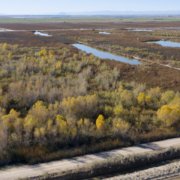Nine-thousand trees, mostly willows, are being planted in the 1,000 acre Managed Marsh wildlife habitat in northern Imperial County.
The planting is part of the final construction phase of the Managed Marsh, located off Highway 111 between the city of Calipatria and Niland.
Funded by the Quantification Settlement Agreement Joint Powers Authority (QSA JPA), the habitat, located close to the Salton Sea, is a key environmental mitigation project to serve the needs of wildlife that depend on area surface drains in the Imperial Valley. With the planting of the 9,000 trees now underway, the Managed Marsh will be completed by early 2022.
Formed under 2003 legislation to administer the funding of environmental mitigation requirements related to the QSA water transfers, the QSA JPA is comprised of the Imperial Irrigation District, San Diego County Water Authority, Coachella Valley Water District and California Department of Fish and Wildlife.
Salton Sea Restoration Projects
As part of the legislation (specifically Senate Bill (SB) 654), the three water agencies of the QSA JPA have a responsibility to fund environmental mitigation projects related to the QSA up to $133 million in 2003 dollars (or $288 million in nominal dollars). The state has the responsibility to cover mitigation costs that exceed the $133 million mark and to address the larger issue of restoration at the Salton Sea. However, the three water agencies also have paid a combined $30 million in 2003 dollars (or $67 million in nominal dollars) as seed money for restoration, which was provided to CDFW as part of the Salton Sea Restoration Fund.
Nine-Thousand Trees for Wildlife in Managed Marsh
The Managed Marsh, built by IID as the implementing arm of the QSA JPA, was funded as part of the $133 million covered by the three water agencies. The project has been constructed over three phases, each 300 acres of marsh, with phase one completed in 2009 in and phase two in 2014. Phase three, the final stage, began last year when as many as 6,000 trees were planted. In total, once the Managed Marsh is completed, the entire facility will consist of more than 17,000 trees as well as wetlands, providing a habitat for more than 60 species of birds and other wildlife.
Public Resource
For years, the Managed Marsh has been open to the public, providing a resource for bird-watching enthusiasts and trail hikers. The facility also is an educational resource for area schools that have used the facility for field trips.
Since the QSA JPA was formed, it has been actively implementing mitigation projects in line with the QSA’s environmental permits, with much of that effort focused on the Salton Sea. For the first 15 years, the QSA JPA funded a fallowing program in the Imperial Valley that provided about 800,000 acre-feet of water to the Salton Sea, both to maintain salinity levels and to give the state time to begin a restoration program. At the same time, the QSA JPA implemented additional projects, like the Managed Marsh, in its ongoing efforts to address environmental mitigation.
Along with working toward the completion of the Managed Marsh, since 2018, the QSA JPA has focused on providing more permanent on-the-ground projects at the Sea, meant to address air quality impacts, including completing nearly 3,000 acres of surfacing roughening projects, with another 7,000 acres in development, growing vegetation, and supporting the reclamation of exposed playa for agricultural development where possible.
The QSA JPA will also be funding a groundwater pilot project as a potential water source for habitat development at the Salton Sea. While separate from the state’s Salton Sea Management Program, these are projects that work hand in hand with restoration in a collaborative effort.




